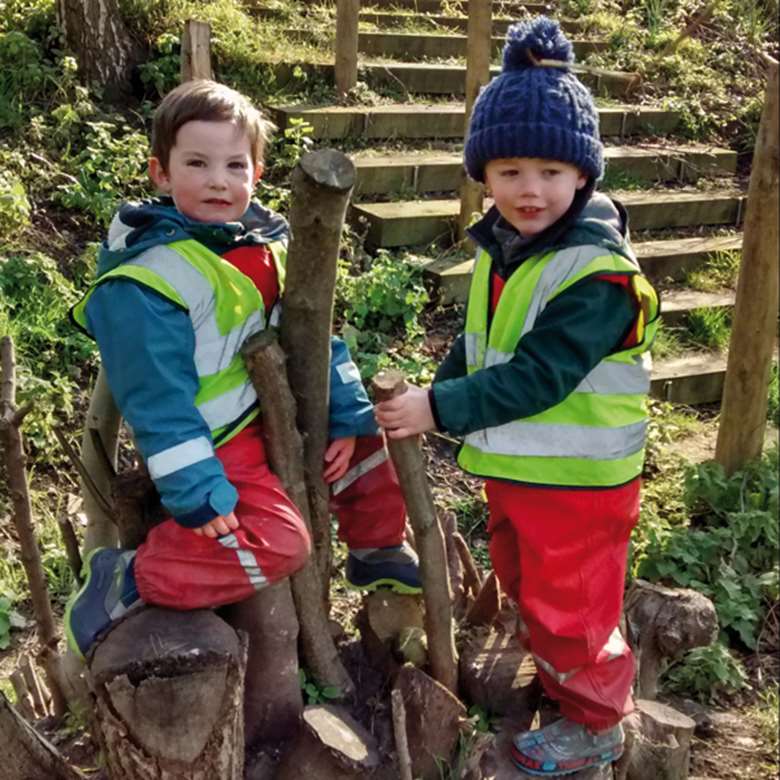Woodland Nursery
Jess Brown
Tuesday, May 10, 2016
London-based nursery inspired by the Forest School approach, where most of the learning takes place outdoors

Outdoor Learning - Practice example: Woodland Nursery
- Applies a model of outdoor learning from Sweden, where the vast majority of the childcare sessions are delivered outside
- Provides childcare for children aged 30 months to five years, with a ratio of one member of staff to two children
- Opened in Greenwich in southeast London in April 2015, and has already achieved an Ofsted "outstanding" rating
ACTION
Childcare at the Woodland Nursery is based on the Forest School approach, which advocates that only in exceptional circumstances should sessions not take place outdoors.
The concept of a hands-on approach to learning in a woodland environment dates back to the 19th century but gained popularity in Scandanavia, before coming to the UK in the early 2000s.
Instead of playing with traditional toys, children at the Woodland Nursery play with natural material, climb trees and use real tools - including saws - alongside sessions that fulfil the education requirements of the Early Years Foundation Stage.
"For these sessions we run a theme for every half term, but we keep it as child-led as possible," says manager Tracy Paskins.
The nursery staff have a hands-off approach, letting the children manage their own risks and learn through free play, Paskins says. "We try to be in the background, supporting them but not making their learning go in any particular direction."
Paskins says she set up the nursery because she realised when her own children were young there was nowhere for them to go that felt like a continuation of their earlier upbringing, where they spent a large amount of time outdoors.
"I've spoken to lots of other parents who felt the same - they felt that they wanted more freedom for their children just to be, to learn, to connect with nature and be outside regardless of the weather," she says, adding that they will only stay indoors if there are high winds, and will stay away from the woodland area during thunder and lightening.
"The children that learn to manage risk themselves are more adept at doing that than you'd ever imagine," Paskins says. "I'm not saying we don't have falls and bumps, but they are much more able to deal with that."
The nursery staff teach children to put their waterproof clothing on themselves, and are given as much time to do so as needed.
A typical day starts off with the children getting into their waterproof clothing and collecting their equipment for the day. It is then a short walk to the woodland site, where the staff and children do a risk assessment of the area.
She says: "We'll look for rubbish or anything that shouldn't be on the ground, and look at branches that might fall down. Then it's free play for the first half-hour or so.
"Over snack time we might introduce a planned activity. At the moment, we're talking about creativity and literacy. Then we'll go to base camp around the fire. We might have a story and reflective time to give everyone the opportunity to say to the group what they've been doing that day."
Paskins says there are many benefits to the outdoor learning approach, although acknowledges research into this is scarce.
"One of main things is that it is amazing for their self-confidence," she says, adding that it is particularly good for children with special education needs (SEN).
The nursery has a large number of children with SEN, in particular with autistic spectrum and attention deficit disorders.
"For those children the benefits are incredible," she says. "It gives them the freedom, they're not confined. They can just go at their pace; it gives them so much independence and an idea of what they like and don't like."
Outdoor learning also improves children's motor skills and reinforces healthy lifestyle messages, Paskins says.
In addition, it helps children understand how the life cycle works and their place in the world - and has benefits for their concentration, too.
"The more children move and experiment with their bodies, the easier it is for them to sit when they need to sit - for a two-year-old, sitting still is virtually impossible," she explains.
"Allowing them freedom and movement and understanding how their body works means they actually understand what downtime means.
"Their concentration is off the scale for their age because they can really focus when they want to."
IMPACT
The Woodland Nursery was rated "outstanding" in all four key areas when it was inspected by Ofsted in September 2015. The inspection report states the nursery provides "limitless" opportunities for children to explore, investigate and work together.
"Children are highly motivated and independent learners," it adds, praising their progress in maths specifically.
"Children are extremely well prepared for their future learning, including starting school."
Ofsted also concluded that children develop high levels of independence, and very good communication, language and thinking skills.
The high staff-to-child ratio was also reflected in the strong relationships children formed with nursery staff, it adds.
This practice example is part of CYP Now's special report on outdoor learning. Click here for more




